Hello Everyone,
During this time of social distancing I thought I would share an article from one of the Society’s previous newsletters.
The following post are a collection of excerpts taken from an article written by Chris Packman, and was originally published in the OxHS Newsletter of January 2014. It is based on Eleanor Gardhouse’s presentation: Woodstock as it Was; which she presented to the Society on Wednesday, October 30, 2013, at the Woodstock Museum, NHS. The postcards are from Don Wilson’s collection.
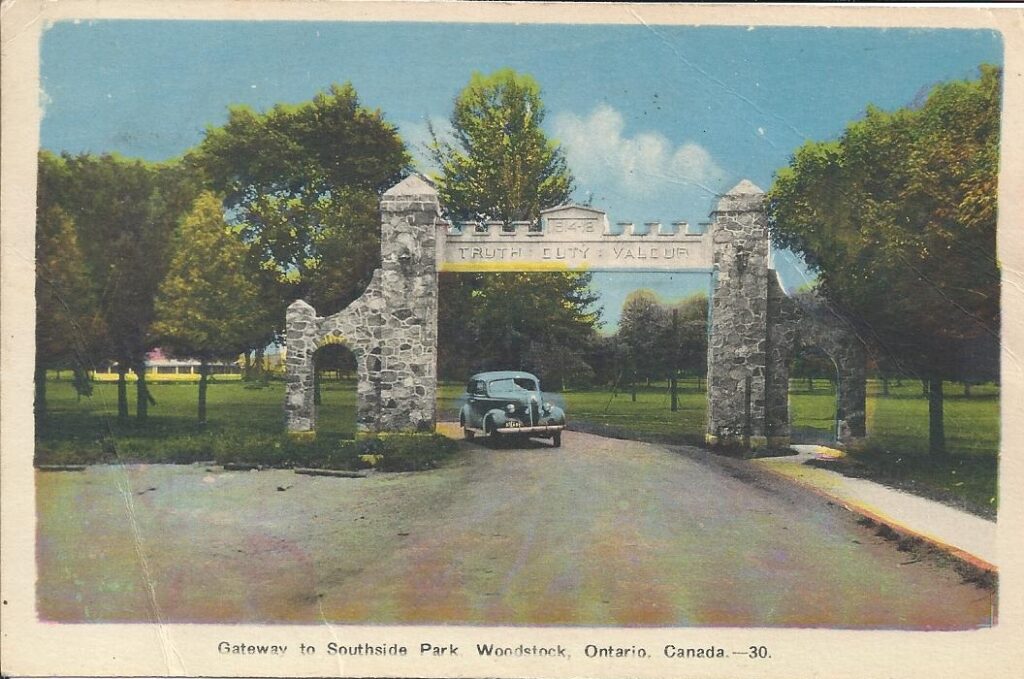
“Truth, Duty Valour” was embossed on the Memorial Gateway to Southside Park Woodstock, at the south end of Victoria Street. In the park, on the east side of its driveway, was once a picnic pavilion from which the band from Norwich, the Lions Club, the Salvation Army or the militia would give concerts in July and August. Today, it’s gone.
The Southside Park pond, fed by Cedar Creek, had changing rooms for boys and girls. It was popular for swimming, and fun to jump off the dam at its exit. But you took care in the spring because upstream was a slaughterhouse: sometimes, stuff got in the water and Dick Sales, the drover, got scolded. Even when drunk, frequently, Dick could look at a cow, tell you how much it weighed and its dollar value. His brother Jack loaned money: useful if you needed a loan to buy a farm or a house. But miss a payment and Jack would foreclose.
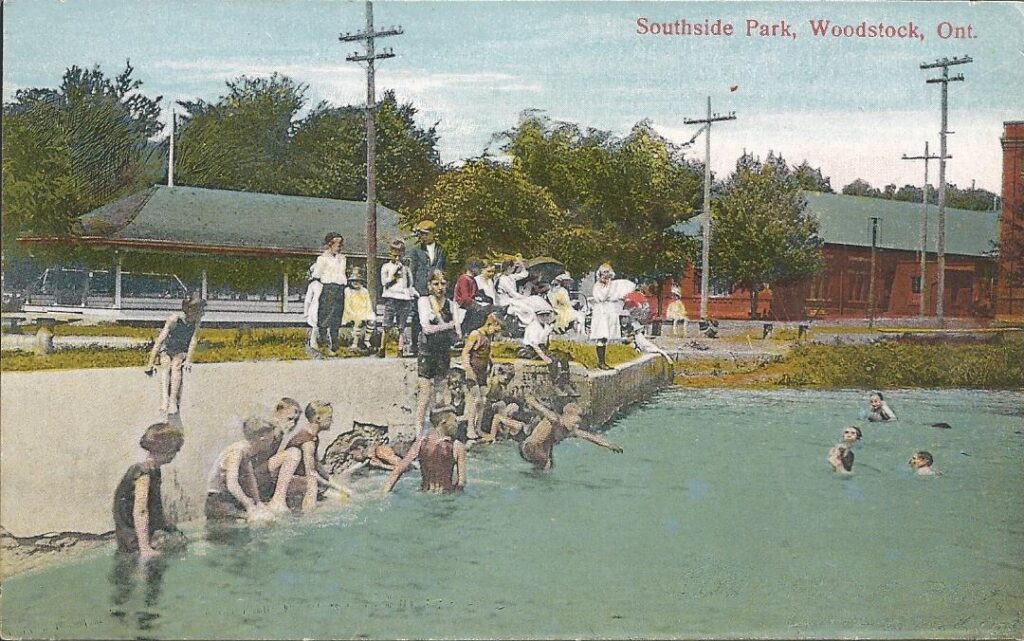
There was a hydro power station near the pond. Close by was the city’s waterworks with a beautiful rock garden in front, created by a man who worked there. East of the power station was the railway line from Stratford, south to Port Dover. If you lived in Curries, and went to school in Woodstock, you’d hop on a train there into Woodstock.
Eleanor showed several pictures showing the changes over the decades in retail ownership around Civic (Museum) Square. An Imperial Bank was at the east corner of the Square, its front on Dundas St. Upstairs were rooms that bank staff could rent. The late Ed Bennett told Eleanor that, on Sunday afternoons, they used to fill the bathtubs full of water, put beer bottles in them to cool, then play poker all afternoon.
Eleanor reminisced, “At Christmas time, people used to come from all over to buy fine linens and beautiful clothes at the John White store, 425-429 Dundas. Right in front of where the elevator was, there were stools where young members of staff would sit. A customer would come in and go to one of the counters to buy something; a lady would write out a bill, take your money and put it into a little round container; pop it into a pneumatic tube and, whoosh, it would be gone. And, on the other side of the elevator, up high, with some steps going up to it, was a platform with a railing around it. That’s where the money would go. The person up there would put the change in the container and return it back down. The girls sitting beside the elevator would watch where the customers were, and the sales lady would signal one of them and you’d go over, pick up their parcel, and take it over to where, under where they were sorting the money, there was a table, paper and string. You had to learn how to break that string without hurting yourself. And you would carefully take the parcel back to the customer and present it to them.”
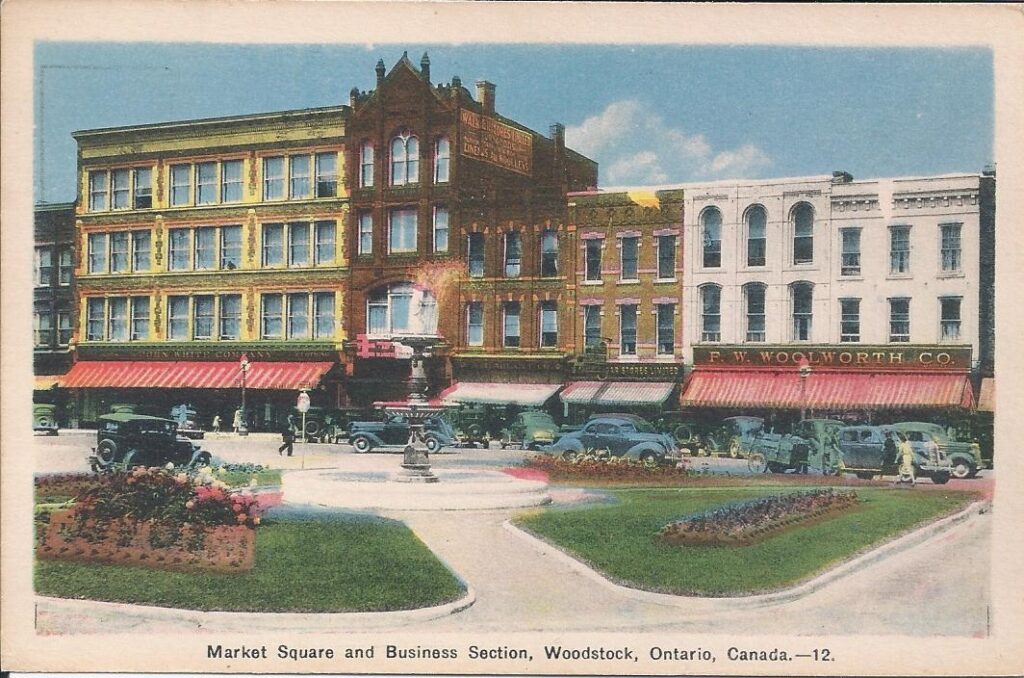
West down the street was the Opera House [at one point, seating 1400]. After variations on this name, it began showing movies, as the “Capital Theatre”, until it closed in the late 1990s.
Going East, Frank Hyde Drugstore [397 Dundas] was right on the corner of Light Street. Next to it was the Princess theatre, at 399 Dundas, which opened in 1916 and showed movies until 1948. When you went into the show, there was only one aisle and seats on each side; very, very narrow. For 10 cents on Saturday, you could watch the Lone Ranger, or Buck Rogers. Nearby were two good Chinese restaurants: Food Rite, 407 Dundas; Canton at 411: very good Chinese food.
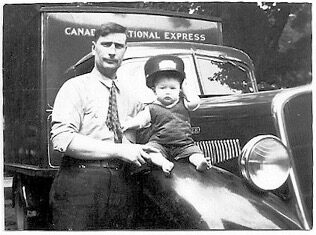
Eleanor showed a street picture, a few doors east of the old post office (now City Hall) that including two horse- drawn buggies in the street. The uniformed CN Express driver with a peak cap on one of them was Eleanor’s father, John Russell Adam. The next picture showed one of the motorized delivery trucks that replaced the buggies. Her dad has his arm around a little girl sitting on a fender, wearing his peaked cap. She still has the cap.
Photo courtesy of Eleanor Gardhouse
Down at the former GTR [now VIA] train station, when a steam train came in, its fireman would reach out, grab a chain to pull down a pipe leading from a trackside water tank, and top up the water reservoir in the train’s tender. This, in turn, fed the boiler.
Eleanor showed the station. “Now the telegraph office is right here and has a bay window so the person inside could look out, up and down the track, because his desk was right up in that window. If the train was not going to stop in Woodstock, but there had to be a message sent, they had a hoop made of bamboo, with a long stick on it. The telegrapher would tie the message to it and he’d stand out by the train track with his hand held up in the air. The engineer would simply reach out of his window as the train was going through, take the message off and then drop the hoop.”
“Now when a new messenger (telegrapher) would come, sometimes, not every time, Dad would come home and say, “New messenger”. If it was a warm day, Mom [once a trained telegrapher] would go and stand outside that window and she’d listen to what he would [hand key]. Now they didn’t always just send messages, they gossiped and told dirty stories.
When he signed off … you can’t imagine how surprised he would be when mother, this little lady with grey hair standing there, told him what he had just said.”
She had pictures and stories of some of the city’s hotels: Hotel Oxford, once the most ritzy in Woodstock, just across from the Museum; the Commercial Hotel on Graham Street, now renovated as the Econolodge; the
Royal Hotel on the corner of Brock Street and Dundas, that burnt on Christmas Eve, 1970. A credit union is now at that site. Ted’s log cabins were on Norwich, just before Parkinson road: a nice place to stay; or, Houser’s Motel, on the present site of Zehrs on Dundas.
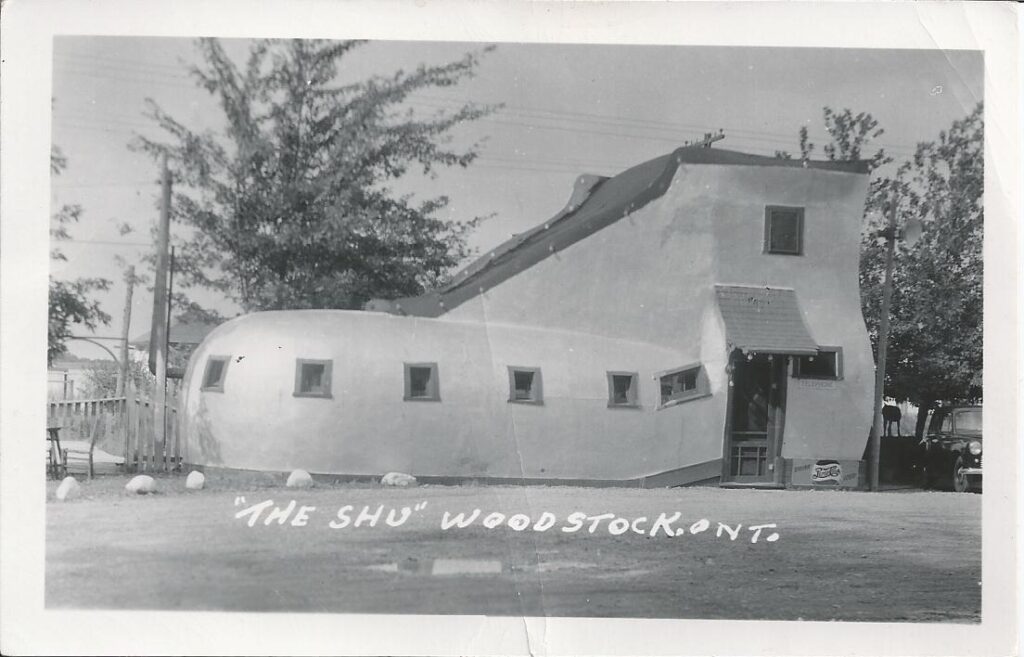
Not forgetting places to eat: Ye OldeShu where Rochdale Credit Union is now (943 Dundas), or the Terrace Tea Gardens on the Beachville Road. Its owners closed it, moved it to Woodstock and opened on the site of what is now Bronson’s.
Eleanor closed with several aerial photographs taken in 1919. The city was smaller then; homes giving way to grassy fields north of Ingersoll Avenue.
